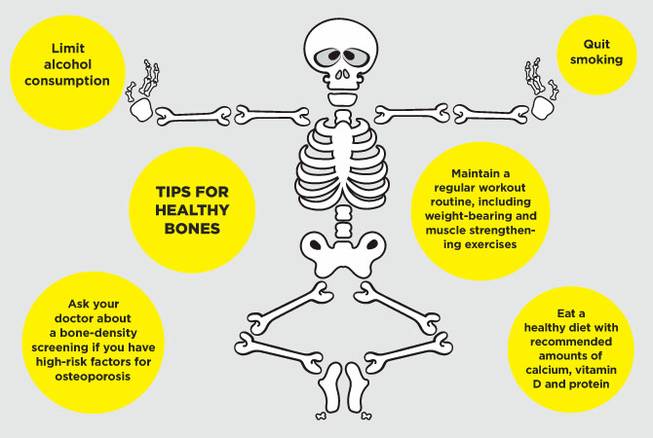
Monday, May 15, 2017 | 2 a.m.
Maintaining healthy bones is one of the most important things anyone can do for their body — and it should be prioritized during every stage of life.
While serious conditions like osteoporosis tend to affect older people, taking care of your bones when you’re young can prevent the development of bone disease later. “Everyone should be concerned about their bone health,” said Fred Redfern, MD, orthopedic surgeon and medical director of Geriatric Fracture Quality Program at Sunrise Hospital and Medical Center.
Regardless of age, gender, lifestyle or general healthfulness, good bone quality is critical.
What do bones do?
Adults have 206 bones which are comprised primarily of collagen and calcium. The outer part of the bone is a solid, thick mass while the inner part is spongy, hollow in places and contains bone marrow.
First and foremost, bones provide the structure and framework for the entire body and allow us to move. They also protect internal organs from injury (the skull protects the brain, ribs protect the lungs and heart, etc.).
But bones do more than supply a hard skeleton for otherwise soft tissue. Bones are made of living, growing and regenerating cells that play an active role in the body’s ecosystem.
Other important functions of the bone include:
• Blood cell production: Red bone marrow produces red blood cells, platelets and most white blood cells.
• Mineral balance: Bones store the body’s calcium (and some phosphorus) that can be broken down and released into the bloodstream when mineral levels are low.
• Nutrient storage: Yellow bone marrow stores fat that your body reserves for energy when necessary (usually under extreme conditions, such as starvation).
How bones change with age
Throughout our lives, new bone cells are produced and old ones are broken down, but the majority of bone growth occurs while we’re young.
“We reach peak bone mass density between the ages of 20 and 30,” Redfern said. Once the rate that bone is broken down begins to outpace the rate by which it’s produced, bone mass density starts to decline.
The amount of bone mass you have in your 30s will need to support what you lose over time, otherwise you may get osteoporosis. The development of osteoporosis first depends on the amount of bone density amassed at its peak, and secondly on how quickly it diminishes with age.
Osteoporosis
Osteoporosis is a disease that makes bones weak and easily prone to fractures. The National Osteoporosis Foundation (NOF) estimates that 54 million Americans have osteoporosis and/or low bone mass.
Common risk factors include age, family history, calcium/vitamin D deficiencies, poor diet, lack of exercise, smoking, excess alcohol consumption, certain medications and other diseases/disorders.
Women are more likely to develop osteoporosis than men because of lowered estrogen levels following menopause. “Postmenopausal women can lose bone rapidly and should have their bone density checked on a regular basis,” Redfern said.
Treating osteoporosis
Osteoporosis can be screened for and diagnosed with an X-ray but many patients don’t know they have the disease until they break a bone. Because of this, duel treatments often are required for osteoporosis patients: one to help rebuild bone density, and the other to treat the injury caused by it.
Addressing bone density loss: “Improving bone density involves taking calcium and vitamin D supplements. If the osteoporosis is severe, there are drugs that can help build the bone back up,” Redfern said. A specialized exercise plan also can be beneficial, as well as limiting other contributors such as drinking and smoking.
Addressing osteoporotic injuries: Any bone is susceptible to fracture in osteoporosis patients, but the NOF reports that the hips, spine and wrists are most commonly injured. Treatment methods include casts/braces, physical therapy, bone-support implantation surgery and joint replacement surgery.
While there are effective treatments available for osteoporotic injuries, the patient’s age and bone quality can make the recovery process difficult.
The NOF reports that 20 percent of seniors who break a hip die within the year, either because of complications from the injury or from the corrective surgery. Because there are many risks associated with bone fractures in the elderly, a dedicated and specialized approach is important for successful treatment.
“We created the Geriatric Fracture Quality Program to streamline care for patients with hip fractures, and incorporate the American Orthopedic Association’s ‘Own the Bone’ program to address post-fracture management for osteoporosis patients,” Redfern said.
Tips for healthy bones
• Quit smoking
• Take a calcium and vitamin D supplement if you’re not getting enough through diet alone
• Limit alcohol consumption
• Eat a healthy diet with recommended amounts of calcium, vitamin D and protein
• Ask your doctor about a bone-density screening if you have high-risk factors for osteoporosis
• Maintain a regular workout routine, including weight-bearing and muscle strengthening exercises

Join the Discussion:
Check this out for a full explanation of our conversion to the LiveFyre commenting system and instructions on how to sign up for an account.
Full comments policy